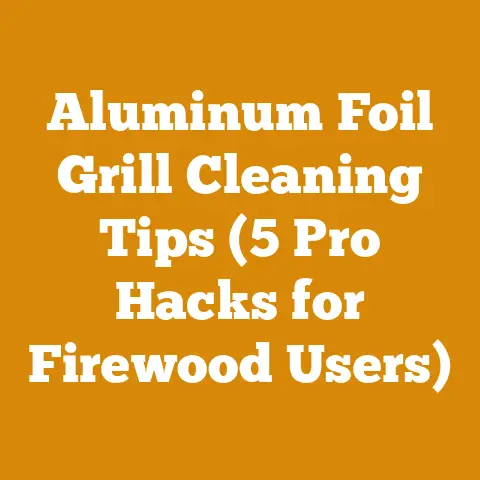Creosote Burning Logs Explained (5 Proven Chimney Tips)
Aha! It hit me like a rogue branch to the face – creosote isn’t just a nuisance; it’s a serious fire hazard lurking in your chimney. For years, I dismissed the occasional soot flakes as a minor inconvenience. But after witnessing a neighbor’s chimney fire, I dove deep into understanding creosote, how it forms, and, most importantly, how to prevent it. What I discovered changed everything about how I burn wood, and I’m here to share that knowledge with you. Let’s get started on keeping your home safe and warm.
Creosote Burning Logs Explained: 5 Proven Chimney Tips
Creosote. It’s a word that strikes fear into the hearts of wood-burning enthusiasts. And rightfully so. It’s a byproduct of burning wood that accumulates in your chimney and, if left unchecked, can lead to devastating chimney fires. I’ve seen the aftermath firsthand – the charred remains of a home, the frantic efforts of firefighters, and the heartbroken expressions of homeowners who thought they were doing everything right. Don’t let that be you.
What is Creosote?
Creosote is a tar-like substance formed when wood burns incompletely. The smoke, gases, and unburned particles condense as they travel up the chimney, sticking to the flue walls. Think of it like cholesterol in your arteries, but for your chimney. It builds up over time, layer upon layer, becoming increasingly flammable.
The Three Stages of Creosote Formation
Understanding the different forms of creosote is crucial for effective prevention and removal:
- Stage 1 (Light and Sooty): This is the easiest to remove. It’s typically a dry, flaky deposit that can be brushed away relatively easily. This stage indicates cooler burning temperatures and incomplete combustion.
- Stage 2 (Hard and Shiny): This form is more difficult to remove. It’s a hard, shiny, and sometimes flaky deposit. It’s more flammable than Stage 1 and requires more aggressive cleaning methods.
- Stage 3 (Glistening and Tar-Like): This is the most dangerous form. It’s a thick, tar-like substance that’s extremely flammable and difficult to remove. Stage 3 creosote often requires professional chimney cleaning and may even necessitate chimney repairs or replacement.
Why is Creosote Dangerous?
The danger lies in its flammability. A chimney fire can reach temperatures of over 2,000 degrees Fahrenheit, which can easily ignite surrounding structures, leading to a house fire. Additionally, creosote buildup can restrict airflow in your chimney, leading to carbon monoxide poisoning. Carbon monoxide is a silent killer, an odorless and colorless gas that can be deadly. I’ve personally known people who’ve experienced carbon monoxide leaks due to blocked chimneys – a chilling reminder of the importance of chimney maintenance.
5 Proven Chimney Tips to Prevent Creosote Buildup
Now that we understand the dangers of creosote, let’s dive into the practical steps you can take to minimize its formation and keep your chimney safe.
1. Burn Seasoned Firewood
This is the single most important factor in preventing creosote buildup. Seasoned firewood has a moisture content of 20% or less. Wet or “green” wood contains significantly more moisture, which lowers the burning temperature and leads to incomplete combustion, resulting in more smoke and creosote.
- How to Season Firewood:
- Split the Wood: Splitting wood increases the surface area exposed to air, speeding up the drying process. I typically split my wood into pieces that are 4-6 inches in diameter.
- Stack it Properly: Stack the wood in a single row, off the ground, with good air circulation. I use pallets or scrap lumber to elevate the wood.
- Location Matters: Choose a sunny and windy location for your woodpile. This will help the wood dry faster.
- Cover the Top, Not the Sides: Covering the top of the woodpile will protect it from rain and snow, while leaving the sides open allows for air circulation.
- How Long to Season: Hardwoods like oak and maple typically take 6-12 months to season properly. Softwoods like pine and fir may season in as little as 3-6 months.
- Measuring Moisture Content:
- Moisture Meter: The most accurate way to determine if your wood is seasoned is to use a moisture meter. These devices measure the percentage of moisture in the wood. Aim for a reading of 20% or less. I use a moisture meter religiously before I burn any wood.
- The “Sizzle” Test: Bang two pieces of wood together. Seasoned wood will produce a hollow sound, while wet wood will sound dull. You can also listen for a hissing or sizzling sound when burning – this indicates moisture.
- Visual Inspection: Seasoned wood will have cracks in the end grain and will be lighter in weight than green wood.
- Wood Species and Creosote:
- While all wood can contribute to creosote buildup if burned improperly, certain species tend to produce less creosote than others. Hardwoods like oak, maple, ash, and birch generally burn cleaner than softwoods like pine, fir, and spruce. However, the key factor is still moisture content. Even hardwoods will produce excessive creosote if they are not properly seasoned. I’ve found that a mix of hardwoods provides the best balance of heat output and clean burning.
Takeaway: Burning seasoned firewood is non-negotiable. Invest in a moisture meter and learn to identify properly seasoned wood. Your chimney will thank you.
2. Burn Hotter Fires
While it might seem counterintuitive, burning hotter fires can actually reduce creosote buildup. Hotter fires promote more complete combustion, which means less smoke and unburned particles are released into the chimney.
- Airflow is Key: Ensure that your stove or fireplace has adequate airflow. Open the air vents fully when starting a fire and adjust them as needed to maintain a hot, clean burn. I often use a small fan to help circulate air around the firebox when starting a fire.
- Don’t Smolder: Avoid smoldering fires, as these produce a lot of smoke and creosote. Smoldering fires occur when there’s not enough oxygen to support complete combustion.
- Top-Down Burning: Consider using the top-down burning method. This involves placing larger logs on the bottom and smaller kindling on top. This method promotes a hotter, cleaner burn.
- Smaller, More Frequent Loads: Instead of loading your stove with a large amount of wood at once, try burning smaller, more frequent loads. This will help maintain a consistent, hot fire.
- Monitoring Flue Temperature:
- Ideally, flue temperatures should be between 250°F and 500°F for wood stoves and 400°F to 700°F for fireplaces during active burning. Too low, and you’re promoting creosote formation; too high, and you risk damaging your chimney. I use a magnetic thermometer attached to the flue pipe to monitor the temperature. This gives me a real-time indication of how efficiently the fire is burning.
- Adjusting Airflow: If the flue temperature is too low, increase the airflow by opening the air vents. If it’s too high, reduce the airflow. Remember, it’s a balancing act.
- Wood Type Impact: Different wood types burn at different temperatures. Hardwoods generally burn hotter and longer than softwoods. Keep this in mind when selecting your firewood.
Takeaway: Strive for hot, clean-burning fires. Monitor airflow and flue temperature to ensure optimal combustion.
3. Regular Chimney Inspections and Cleaning
Even with the best burning practices, some creosote buildup is inevitable. That’s why regular chimney inspections and cleaning are essential.
- Annual Inspections: Have your chimney inspected by a qualified professional at least once a year, even if you don’t use your fireplace frequently. A professional can identify potential problems, such as cracks, blockages, or excessive creosote buildup.
- Cleaning Frequency: The frequency of chimney cleaning depends on how often you use your fireplace and the type of wood you burn. However, as a general rule, have your chimney cleaned if you have 1/8 inch or more of creosote buildup.
- DIY vs. Professional Cleaning:
- DIY Cleaning: If you’re comfortable working on your roof and have the right tools, you can clean your chimney yourself. This typically involves using a chimney brush to scrub the flue walls. I’ve cleaned my own chimney for years, but it’s not for everyone.
- Professional Cleaning: Hiring a professional chimney sweep is the safest and most thorough option. Professionals have the experience, tools, and training to properly clean your chimney and identify potential problems. I still have my chimney professionally inspected annually, even though I clean it myself.
- Tools for DIY Cleaning:
- Chimney Brush: Choose a brush that is the correct size and shape for your chimney flue. Round brushes are typically used for round flues, while square or rectangular brushes are used for square or rectangular flues.
- Extension Rods: You’ll need extension rods to reach the entire length of your chimney.
- Dust Mask and Eye Protection: Protect yourself from dust and debris.
- Drop Cloths: Cover your fireplace and surrounding area to protect it from soot.
- Recognizing Warning Signs:
- Smoke Smell: A persistent smoke smell in your home, even when the fireplace is not in use, can indicate a chimney blockage or creosote buildup.
- Poor Draft: If your fireplace is difficult to light or smoke is coming back into the room, it could be a sign of a blocked chimney.
- Visible Creosote: If you can see creosote buildup in your fireplace or chimney, it’s time for a cleaning.
Takeaway: Don’t neglect chimney maintenance. Schedule regular inspections and cleanings to prevent dangerous creosote buildup.
4. Install and Maintain a Chimney Cap
A chimney cap is a simple but effective device that can prevent a variety of problems, including creosote buildup.
- Keeps Out Rain and Snow: Rain and snow can damage your chimney and promote creosote formation. A chimney cap prevents moisture from entering the chimney.
- Prevents Animal Entry: Animals like birds, squirrels, and raccoons can build nests in your chimney, blocking airflow and creating a fire hazard. A chimney cap with a screen will keep these critters out. I once had a family of squirrels take up residence in my chimney – it was a nightmare to remove them!
- Reduces Downdrafts: A chimney cap can help reduce downdrafts, which can cause smoke to enter your home.
- Spark Arrestor: Many chimney caps include a spark arrestor, which prevents sparks from escaping the chimney and potentially starting a fire.
- Installation and Maintenance:
- Proper Sizing: Choose a chimney cap that is the correct size for your chimney.
- Secure Installation: Ensure that the chimney cap is securely attached to your chimney.
- Regular Inspection: Inspect your chimney cap regularly for damage or debris.
- Cleaning: Clean the chimney cap periodically to remove any buildup of soot or debris.
- Types of Chimney Caps:
- Standard Chimney Cap: This is the most common type of chimney cap. It’s a simple, inexpensive way to protect your chimney from the elements.
- Decorative Chimney Cap: These caps add a touch of style to your chimney.
- Multi-Flue Chimney Cap: These caps are designed for chimneys with multiple flues.
- Draft-Increasing Chimney Cap: These caps are designed to improve the draft in your chimney.
Takeaway: Invest in a quality chimney cap and keep it properly maintained. It’s a small investment that can provide significant benefits.
5. Consider Creosote Sweeping Logs (Use with Caution)
Creosote sweeping logs are chemical logs that are burned in your fireplace to help loosen creosote deposits in your chimney. However, they should be used with caution and are not a substitute for regular chimney cleaning.
- How They Work: Creosote sweeping logs contain chemicals that react with the creosote, causing it to dry out and become more brittle. This makes it easier to remove during a subsequent chimney cleaning.
- Effectiveness: The effectiveness of creosote sweeping logs varies depending on the type and amount of creosote buildup. They are generally more effective on Stage 1 and Stage 2 creosote.
- Limitations: Creosote sweeping logs will not remove heavy deposits of Stage 3 creosote. They can also be ineffective if your chimney is already heavily blocked.
- Proper Usage:
- Follow Instructions: Always follow the manufacturer’s instructions carefully.
- Ventilation: Ensure that your fireplace and chimney are properly ventilated.
- Supervision: Never leave a burning creosote sweeping log unattended.
- Post-Treatment Cleaning: After burning a creosote sweeping log, have your chimney professionally cleaned to remove the loosened creosote.
- Potential Risks:
- Incomplete Removal: Creosote sweeping logs may not remove all of the creosote buildup.
- Chimney Damage: In some cases, the chemicals in creosote sweeping logs can damage your chimney.
- False Sense of Security: Relying solely on creosote sweeping logs can create a false sense of security, leading to neglect of regular chimney cleaning.
- Alternative Solutions:
- Professional Chimney Cleaning: This is the most effective way to remove creosote buildup.
- Improved Burning Practices: Burning seasoned firewood and burning hotter fires will help prevent creosote buildup in the first place.
Takeaway: Creosote sweeping logs can be a helpful supplement to regular chimney cleaning, but they should not be used as a substitute. Always follow the manufacturer’s instructions and have your chimney professionally cleaned after use.
Additional Tips for a Safe and Efficient Wood-Burning Experience
Beyond the five key tips above, here are some additional practices I’ve learned over the years that can significantly improve your wood-burning experience and further minimize creosote formation:
- Proper Fireplace Size: Ensure your fireplace or wood stove is appropriately sized for the space you’re heating. An oversized fireplace will struggle to reach optimal burning temperatures, leading to incomplete combustion. I learned this the hard way when I installed a massive fireplace in a relatively small room. It looked impressive, but it was a creosote-generating machine!
- Air Supply: Make sure your fireplace has an adequate air supply. If your home is tightly sealed, consider installing an outside air kit to provide a direct source of fresh air to the fire. This will improve combustion and reduce the risk of carbon monoxide buildup.
- Avoid Burning Trash or Treated Wood: Never burn trash, plastics, or treated wood in your fireplace. These materials release harmful chemicals into the air and can contribute to creosote buildup.
- Proper Ash Disposal: Dispose of ashes in a metal container with a tight-fitting lid. Store the container away from combustible materials. I once had a near miss when I stored hot ashes in a cardboard box – it started smoldering and could have easily caused a fire.
- Carbon Monoxide Detectors: Install carbon monoxide detectors on every level of your home, especially near sleeping areas. Test the detectors regularly to ensure they are working properly.
Understanding Wood Stove Efficiency
Wood stove efficiency is a measure of how much of the wood’s energy is converted into usable heat. A more efficient wood stove will burn cleaner and produce less creosote.
- EPA Certification: Look for wood stoves that are EPA-certified. EPA-certified stoves meet strict emission standards and are more efficient than non-certified stoves.
- Catalytic vs. Non-Catalytic Stoves:
- Catalytic Stoves: These stoves use a catalytic combustor to burn off smoke and gases, resulting in a cleaner and more efficient burn.
- Non-Catalytic Stoves: These stoves rely on advanced firebox design to achieve clean burning.
- Proper Installation: Proper installation is crucial for wood stove efficiency. Follow the manufacturer’s instructions carefully or hire a qualified professional to install your stove.
- Maintenance: Regular maintenance, such as cleaning the flue and inspecting the door seals, will help maintain wood stove efficiency.
The Science of Combustion
Understanding the science of combustion can help you burn wood more efficiently and reduce creosote buildup.
- The Fire Triangle: Fire requires three elements: heat, fuel, and oxygen. Removing any one of these elements will extinguish the fire.
- Complete vs. Incomplete Combustion: Complete combustion occurs when all of the fuel is burned, resulting in carbon dioxide and water vapor. Incomplete combustion occurs when there is not enough oxygen to burn all of the fuel, resulting in smoke, carbon monoxide, and creosote.
- Factors Affecting Combustion: Factors that affect combustion include the type of fuel, the amount of oxygen, and the temperature.
- Optimizing Combustion: To optimize combustion, use seasoned firewood, ensure adequate airflow, and maintain a hot fire.
Case Studies: Real-World Examples
To illustrate the importance of creosote prevention, let’s look at a few real-world case studies:
- Case Study 1: The Neglected Chimney: A homeowner in rural Maine neglected to have their chimney cleaned for several years. Creosote built up to a dangerous level, and a chimney fire erupted, causing significant damage to their home. The fire was eventually extinguished, but the homeowner faced costly repairs and the trauma of a near-disaster.
- Case Study 2: The DIY Disaster: A well-intentioned homeowner attempted to clean their chimney themselves but used the wrong type of brush. They damaged the flue liner, creating cracks that allowed smoke and gases to leak into their home. They were fortunate to discover the problem before anyone was harmed, but they had to pay a professional to repair the chimney.
- Case Study 3: The Smart Burner: A homeowner in Colorado followed all of the recommended creosote prevention tips, including burning seasoned firewood, burning hotter fires, and having their chimney inspected and cleaned annually. They never experienced any problems with creosote buildup and enjoyed a safe and efficient wood-burning experience for many years.
These case studies highlight the importance of taking creosote prevention seriously. It’s not worth risking your home and your family’s safety.
Common Mistakes to Avoid
Here are some common mistakes that can lead to creosote buildup:
- Burning Unseasoned Firewood: This is the most common mistake.
- Smoldering Fires: Avoid smoldering fires, as they produce a lot of smoke and creosote.
- Neglecting Chimney Maintenance: Regular chimney inspections and cleanings are essential.
- Using the Wrong Type of Wood: Avoid burning trash, plastics, or treated wood.
- Ignoring Warning Signs: Pay attention to any signs of creosote buildup, such as a smoke smell or poor draft.
The Future of Wood Burning
As concerns about air quality and climate change grow, the future of wood burning will likely involve more efficient and cleaner-burning technologies.
- Advanced Wood Stoves: New wood stove designs are incorporating advanced combustion technologies to reduce emissions and improve efficiency.
- Pellet Stoves: Pellet stoves burn compressed wood pellets, which are a renewable and relatively clean-burning fuel source.
- Gasification: Gasification is a process that converts wood into a gas that can be burned more efficiently and with lower emissions.
- Regulations: Stricter regulations on wood burning may be implemented in some areas to reduce air pollution.
Final Thoughts
Creosote is a serious threat, but it’s a manageable one. By following the tips I’ve outlined in this guide, you can significantly reduce creosote buildup in your chimney and enjoy a safe and efficient wood-burning experience. Remember, prevention is key. Burn seasoned firewood, burn hotter fires, have your chimney inspected and cleaned regularly, and install and maintain a chimney cap. And always be aware of the warning signs of creosote buildup. Your home and your family’s safety depend on it. Now go forth and burn responsibly!






